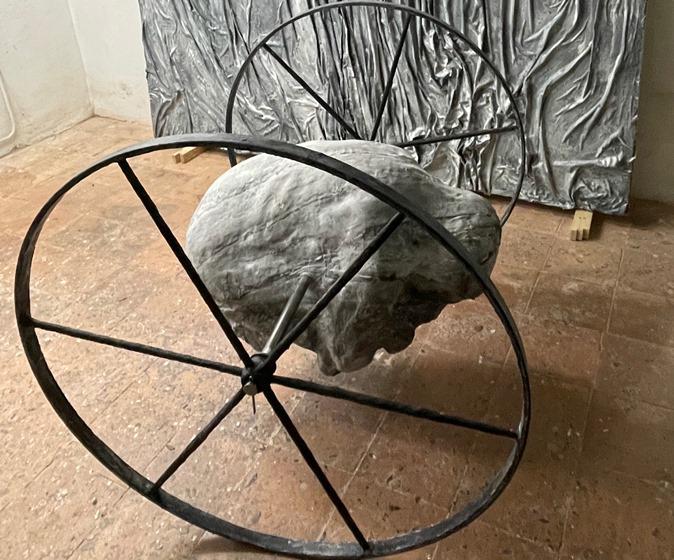José Cobo exhibits with ‘El tejido de la luz’ at the Juan Silió Gallery, in Madrid, from March 25 to May 27.
After several appearances at the Juan Silió Gallery in Santander, to which he has been linked for more than three decades, the works of the sculptor José Cobo now arrive in Madrid, with all their formal forcefulness and existential content.
The result of in-depth research, his creative process is a continuum in which meditation and reflection on the human being is nuclear. His relationship with nature, the social context in which he is inserted and the spirituality that he develops are themes that evolve in his production, finding formal correlates in the different series that he works over time.
Now in ‘The fabric of light’ shows us a selection of his latest works, sculptures mostly made in epoxy resin, with a technique of their own invention, which in many cases tend to be installed. The dialogue of the pieces with the surrounding space is an essential theme for the sculptor, being in many cases the true protagonist of some of his creations: space turned into a pure metaphor for our way of inhabiting the world and relating to our environment. .
Title ‘The fabric of light’ contains the key underlying the exhibited pieces, alluding to the scientific theory that all existing matter is spawn in the stars. This poetic affirmation unleashes the imagination of the artist who is supported by the fruitful concept of fold developed by Deleuze to talk about that cosmic process of diversification that goes from light to the reality that we know, those infinite folds that in its evolution form the world, the folds of matter and in the same way, the folds of the soul.
‘Folds of aerial matter’‘Folds of matter with line’ and ‘Folds of subterranean matter’ are made up of panels in which the fold abounds, in some cases worked in fabrics and stucco, with a leaden and neutral finish; in others with a glossy black finish of treated textile. In all of them there is a reference to the baroque movement, to dramatization and representation. They refer to the organization of the altarpiece, but they are the panels without images. Some are still hanging, others are lowered and rest on the ground apparently disassembled, already detached from their representative function, desacralized, just presented, stripped of iconicity.
In a haunting’Hermaphrodite’, matter seems to have not yet been defined as sex and maintains the ambiguity. The figure of a body with an erased face hangs curiously from the ceiling, uncomfortably displaying both masculine and feminine attributes. The sculpture seems to be unfinished, with screws still attached, as if it really should be placed in another position.
Two ‘liberty meteors‘, one idealized and the other internalized, are two approaches to Giacometti’s famous quadriga. If the Swiss expressed spirituality, Cobo turns it back to matter to speak to us about the concept of freedom of being, both in a generic sense and applied to the individual articulated in society. Two beautiful pieces that suggest complex and highly relevant content today.
Finally, in ‘Metamorphosis’, different isolated scenes come together in a larger dramatized composition. They are characters and objects in different situations, some of them everyday, others symbolic and surreal. Inspired by the strange abnormality experienced in times of pandemic, this mosaic talks about transformation, social behavior and the incidence of the mass media.
The discovery of the ambivalence of light, known since it behaves equally as a wave and a particle, meant for science to assume what seems more like a miracle than a physical certainty. Thus life, which arises from matter, like our mind and our own consciousness as beings who in turn think about the matter that makes them up, capable of elevating this thought to a work of art, delving poetically into the fabric of light.
Visiting hours will be from Tuesday to Friday from 11:00 a.m. to 7:00 p.m. and Saturdays from 11:00 a.m. to 2:00 p.m.
Jose Cobo (Santander, 1958)
The artist graduated from The School of the Art Institute of Chicago in 1985, with the title of Master of Sculpture. In 1994 she obtained the Botín Foundation Scholarship in the II Call for Plastic Arts Scholarships and in 1995, she graduated in Art History and Criticism. In 2014 she won the Cantabria Plastic Arts Award.
In addition, he has been a visiting artist at Vermont Studio School (2009, 2013, 2016), Oxbow at Saugatuck, Michigan (1994, 1996); University of the Basque Country, Bilbao, Faculty of Fine Arts (1986, 2016); Espacio Interior, Museum of Modern and Contemporary Art of Santander and Cantabria MAS (2013), speaker at the fourth Ibero-American ArTecnologia Congress, Complutense University of Madrid, (2018), conference ‘From matter to idea’, Opinion Forum, Casino de Madrid (2018), Master Course focused on his own work at the Menéndez Pelayo International University (UIMP): ‘from existence to the idea’, Santander (2015). From 1994 to 1997 she taught at the Chicago Art Institute.
In his professional career, over 25 years, José Cobo has participated in numerous exhibitions, both individual and collective. He has exhibited in cities like Cologne, Munich or Berlin (Germany) and his presence in the United States stands out in cities like Miami, New York and Chicago, where he exhibits regularly. He has participated in international fairs such as ARCOmadrid, MACO, PULSE New York, Art Chicago or Art Miami and his work is present in important public and private collections.
At the same time, He has carried out numerous interventions in public spacessuch as the “Monument to the fire and Reconstruction of 1941”, the “Two Bulls” at the gate of Plaza de Vista Alegre in Madrid, “Los raqueros” on the Santander promenade, “Wächter” at Arche Nebra, Saxony-Anhalt , Germany, or the recently inaugurated Sculpture Commemorating the 50th Anniversary of the International Piano Competition, Paloma O’Shea, in Santander.
José Cobo exhibits with ‘El tejido de la luz’ at the Juan Silió Gallery, in Madrid

